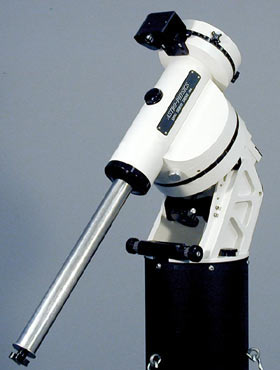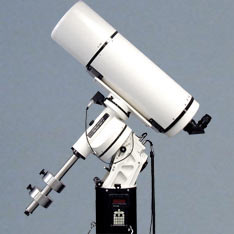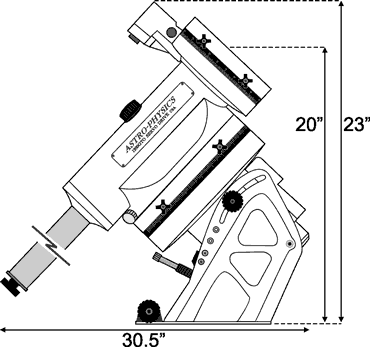1200GTO German Equatorial Mount (1200GTO)
with GTOCP3 Control Box
Includes GTO Keypad and CD with PulseGuide and PEMProAP software
 |
 |
 |
 |
 |
 |
New in 2006
The only significant change to the 1200GTO in 2006 is the redesign of the counterweight shaft. The end of the new 19.5" shaft is machined to accept 9" extensions (M12675). This eliminates the need for the discontinued 28" shaft when mounting a larger scope. The new shaft also features a large diameter machined safety stop (the washer is no longer needed). The new counterweight shaft, extensions and washerless safety stop will be available as upgrades for all older 1200 and 900 mounts. The new extensions and safety knob will NOT fit onto the original counterweight shafts. The photographs on this page do not show this change.
Changes made in 2004 that continue in 2006
For the 2004 and later production runs, we incorporated a number of design changes based on our own experiences with the demands of imaging, customer suggestions and available technology. A brief summary of the changes follows below.
All of these enhancements are described in detail in 1200GTO German Equatorial 2004 Improvements. Best of all, many of these improvements can be made to previous GTO mounts and some of them to all 1200 models produced in the past. These and other upgrades to mounts already in the fields are described in 1200GTO Mount Upgrades and Spare Parts.
All the Latest Upgrades are Included
Here at Astro-Physics we are constantly striving to improve our already outstanding products. Part of our design philosophy is to develop improvements that can also be installed as upgrades on previously produced instruments. If you have an older 1200 mount, be sure to look at the upgrades that are available. If you will be purchasing a new 1200GTO with GTOCP3 Servo Motor Drive, be assured that it contains the latest and most up to date components available, and that no upgrades are needed at this time. Listed upgrades that are already part of the new 1200GTO include but are not limited to the following:
Please note that there may also be several items that are offered as optional accessories for your mount. These items will not be included, but must be purchased separately.
Why a 1200GTO?
With the advent of the CCD camera, amateurs are exploring the skies to an ever increasing level of precision, easily exceeding the image quality of large observatories using film techniques decades ago. This new level puts a higher demand on the precision of the equatorial mounting. Many of the finest imagers today have been using our GTO mounts as a solid platform for a wide variety of instruments. The largest of these is our 1200GTO.
Since its introduction in 1998, the 1200GTO has gained a reputation for both tracking and pointing accuracy, essential to casual visual observation as well as advanced imaging. Quite a few 1200GTO and 900GTO (smaller cousin) mounts can be found at Mount Pinos in California, favorite observing site of many advanced photographers and imagers. Visit the Cool Sites and Gallery sections of our web site to see photos of the mount in action and images taken while using the 1200GTO.
These mounts are truly a marvel of engineering - maximum strength and rigidity with minimum weight. Our CNC lathes and mills carve out the excess material in both axes of the 1200 and 900 German Equatorials while retaining a heavily ribbed structure for internal strength and rigidity. A unique dovetail was machined into the mating surfaces of the R.A. and Dec axes. This feature allows quick and easy assembly in the field without any tools.
The 1200 equatorial is equally at home in a permanent observatory or as a portable mounting for remote star parties thanks to the ease with which the two axes come apart. You CAN have it all. This is the perfect mount for a large refractor, Newtonian, Cassegrain or astrograph. Telescopes commonly used include Astro-Physics 155-206mm refractors, 12-14" Schmidt-Cassegrains and 10-16" Ritchey-Chretiens.
The 1200GTO mount is built from the ground up to be a precision imaging platform while still remaining totally user friendly. Consider these advantages and features:
Flexibility
| Portable. Extremely solid, rugged, high payload mount, yet the equatorial head comes apart in two reasonably light-weight components for hassle-free field setup. No tools needed to assemble the mount in the field. Operate with 12V battery. You can take it to the darkest skies and power it with a commonly available 12V battery. In the observatory, we suggest a minimum 5 amp filtered, regulated power supply. Clutches and setting circles. Allow manual operation if power is not available. |
 |
Precise Mechanical Fabrication.
Highly accurate mechanics.Mechanical Features
| R.A. worm wheel | 10.3" (26.2cm), 225 tooth aluminum |
| Declination worm wheel | 7.2" (18.3cm), 225 tooth aluminum |
| Worm gears | Brass |
| R.A. shaft | 3.35" (8.5cm) diameter |
| R.A. thrust bearings | 9.5" (24.1cm) diameter |
| Dec. shaft | 2.36" (6.0cm)diameter |
| Dec. thrust bearings | 6.5" (16.5cm) diameter |
| Latitude range | 22 to 69 degrees |
| Azimuth adjustment | Approximately 14 degrees |
| Right ascension | 4-minute increments, pointer, engraved both |
| Declination | 1 degree increments, engraved, pointer |
| Setting circles | Porter Slip Ring design, engraved, pointer |
| Capacity |
Approximately 140 lb. (63.6kg) scope and accessories, depending on length. Will accommodate Astro-Physics and similar refractors up to 206mm f8, 16" Cassegrains and Ritchey-Chretiens |
| Weight | Equatorial head: 81
lbs. (36.7 kg), Dec axis is 31 lbs. (14.1kg), RA
axis is 50 lbs. (22.7kg) Counterweight shaft: 14 lbs. (6.4kg) |
Servo Motor Drive
The drive system uses a high-quality Swiss DC servo motor controlled by a microprocessor to an accuracy of 0.05 arc seconds per step. Tracking is very smooth, noticeably smoother than any stepper motor drive or inexpensive servo drive. The system can be accurately controlled over a speed range of 4800:1 which allows 0.25x sidereal for guiding to 1200x sidereal for 5 degrees per second. The circuit draws only 0.4 amps when tracking the stars, 2 amps with both motors slewing and requires only 12 volts to operate. This servo drive will satisfy the requirements of the sophisticated, advanced astrophotographer, yet is easy for the casual, visual observer to use. Please refer to GTOCP3 Control Box and Keypad for Servo Drive for additional information.
Pier Adapter Options
In previous production runs, the Standard Pier Adapter was included with the mount, however there are now two options available for your consideration. If you plan to have multiple pier installations, perhaps one permanent and another portable, you may wish to purchase an extra adapter to install on the the second pier. This will make your setup and switchover much quicker. Many customers have found this to be advantageous.
If you do not purchase one of our pier adapters described below, for instance, if you purchase the Monolith Pier from Particle Wave Technologies, you will need to purchase the Pier Adapter Knob Kit (part# 12KBKIT) in order to attach your mount to the Monolith.
Standard
Pier Adapter (1200SPA)
This 1200 Pier Adapter is
similar to those that we have included with mounts
in the past, however the azimuth adjustment block
is slightly taller to accommodate the new azimuth
adjustor assembly. If you have a permanent
installation, this base is a good choice since you
will not have to set up every session.
Precision-Adjust Rotating
Pier Adapter with Azimuth Bearing (1200RPA)
This pier adapter was designed
for very accurate and smooth adjustment of the azimuth
angle without loosening the lock-down knobs on the
base of the mount. Upgrade your previous model 1200
mount (any version) and enjoy the ease of use.
PulseGuide™ Software
PulseGuide is a stand-alone Windows (98, ME, 2000, NT4, XP only) utility that provides complete remote control of Astro-Physics GTO400, GTOE600, GTO900, and GTO1200 mounts. It derives its name from its most distinctive feature, pulse guiding, which can improve unguided tracking. Specifically, it can help correct tracking errors caused by polar misalignment and atmospheric refraction. You can also train PulseGuide to track objects moving relative to the stars, such as asteroids, comets, and the moon. In addition to pulse guiding, PulseGuide also has many useful utility features. With just a few exceptions, it supports the entire serial Astro-Physics command protocol. More ....
PulseGuide was written by Ray Gralak of Sirius-Imaging. Please refer to his web site http://www.pulseguide.com for further developments and enhancements. The software will be provided on a CD-ROM with your 1200GTO mount. Previous owners of any Astro-Physics mounts can download the software free-of-charge, courtesy of Ray. Many, many thanks to Ray for this powerful program.
PEMProAP Software |
The diagram shows several dimensions that are commonly requested. In addition, if the scope is horizontal and pointing west or south, the measurement from the top of the pier to the middle of the cradle plate is 11.25." Please note that these dimensions will vary somewhat depending on your latitude. We quote them for 42 degrees because that is the latitude of Astro-Physics and all of our equipment is set up that way. It is also a good average value. Please refer to this PDF document of you are planning an observatory and need to know the variations in the horizontal distance from the center of the mount base plate to the center of the declination axis that are caused by different latitude settings. |
| 1200GTO | $9,400.00 |
Copyright © 1999-2006, Astro-Physics, Inc. - All Rights Reserved
This page was last modified:
February 23, 2011
Astro-Physics, Inc.
11250 Forest Hills Road, Machesney Park, IL 61115, U.S.A.
Phone: 815-282-1513 Fax: 815-282-9847